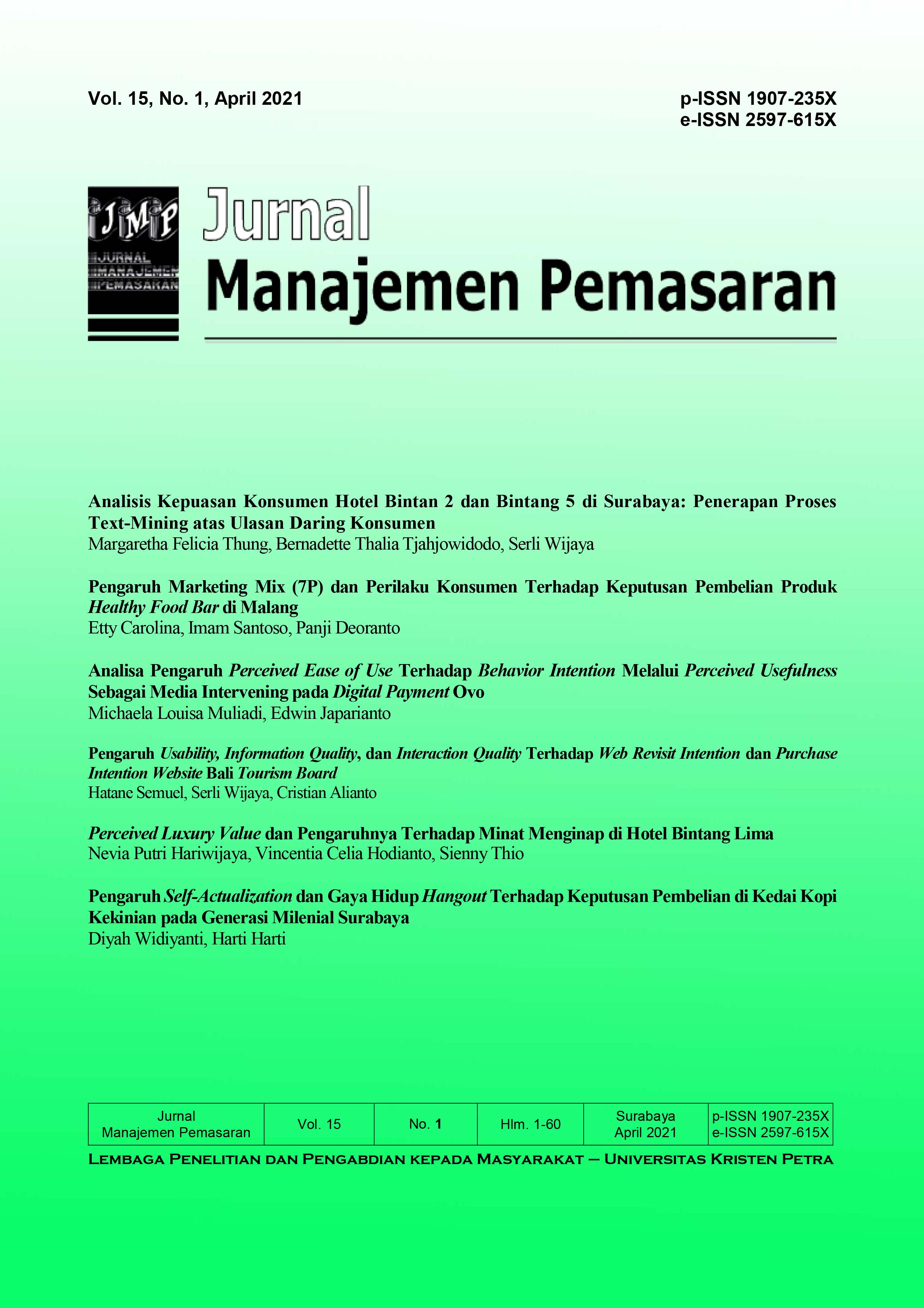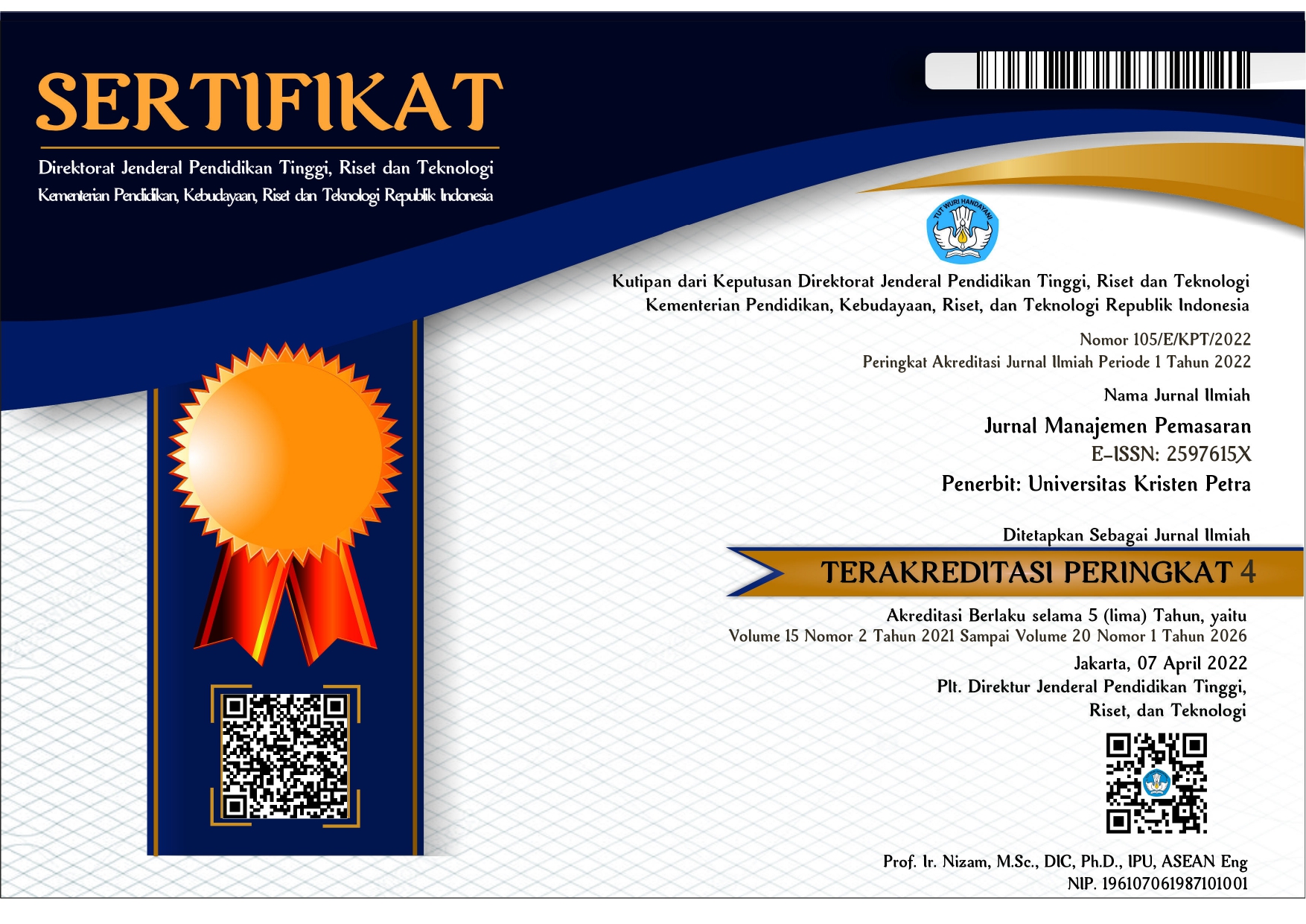THE INFLUENCE OF RESTAURANT ATTRIBUTES ON MUSLIM CONSUMERS TOWARDS SUBSCRIBING HALAL RESTAURANT IN COMPARISON STUDY: BOGOR AND KOTA KINABALU
DOI:
https://doi.org/10.9744/pemasaran.15.2.99-109Keywords:
Halal, Perception RestaurantAbstract
Halal certification does not only mean not only the food served halal but also the entire process must be halal as well. Therefore, Halal certification is important in the aspect of Indonesian and Malaysian food industry especially in the Halal Restaurant. This study objective is to understand the influence of Restaurant’s attribute Restaurant and extrinsic on consumer’s attitude and subscribing of the Halal Restaurant from Malaysian and Indonesian consumers. In addition, this study expecting the result comparison between Bogor and Kota Kinabalu respondent. This study used 200 respondents in total; each city received half of the targeted number of respondents. This study used quantitative method to reach respondents; they are Muslims who wanted to consume Halal food and beverages. The result shows that, among Muslims, we found the different perception towards subscribing Halal Restaurant , we considered that Bogor respondents only give attention in Restaurant service quality attributes when they are subscribing Halal Restaurant Meanwhile, this study found that Kota Kinabalu respondents are very consider about quality, value, and risk. The point of this result is even they are same religion; they still have different perspective and perception.
References
Abdul, M. et al. (2013) ‘Indonesian Small Medium Enterprises (SMEs) and Perceptions on Halal Food Certification’, African Journal Business Management, 7(16), pp. 1492–1500. doi: 10.5897/ AJBM11.2926.
Adiningsih, Kartika Puspitasari (2012), “Analisis kepuasan dan loyalitas konsumen restoran nasi bebek ginyo di Jakarta.” Master’s thesis, Institut Pertanian Bogor
Ajzen, I. (1988). Attitudes, personality, and behavior. Chicago: Dorsey.
Ajzen, I. (1991). The theory of planned behavior. Organizational Behavior and Human Decision Processes, 50, 179–211.
Ajzen, I., & Fishbein, M. (1980). Understanding attitudes and predicting social behavior. Engle-wood Cliffs, NJ: Prentice-Hall.
Ajzen, I., &Fishbein, M. (2005). The influence of attitudes on behavior. In D. Albarracin, B.T. Johnson, & M.P. Zanna (Eds.), The handbook of attitudes (pp. 173–221). Mahwah, NJ: Erlbaum.
Ahmad, S. A. (2019). “Halal Related Malaysian Standards”. Halal Note Series – Halal Common No. 1- 2019
Alzeer, J. & Hadeed, K.A (2016). “Ethanol and its Halal status in food industries”. November 2016Trends in Food Science & Technology 58.
Bauer, R. A. & Greyser, S. A. (1964) Advertising in America: The consumer view. Unpublished Graduate dissertation, Boston, MA: Harvard University
Birgelen, M., Wetzels, M., & de Ruyter, K. (1997). Commitment in service relationships: an empirical test of its antecedents and consequences. Paper presented at the EMAC Conference Proceedings
Bonne, K., & Verbeke, W. (2008). Religious values informing halal meat production and the control and delivery of halal credence quality. Agricul¬ture and Human Values, 25(1), 35-47.
Comrey, A., Lee, H., 2015. A First Course in Factor Analysis, 2nd ed. Lawrence Erlbaum Associa¬tions, Hillsdale, NJ.
Cox, D.F., Introduction” and ”Risk Handling in Consumer Behaviour – an Intensive Study of Two Cases”. In: Cox, Donald F., ed., Risk Taking and Information Handling in Consumer Behaviour, Boston Graduate School of Business Admi¬¬-nistration, Harvard University, Boston 1967.
Cox, D.F. (1967), “Synthesis-perceived risk and information handling”, in Cox, D.F. (Ed.), Risk Taking and Information Handling on Consumer Behaviour, Harvard University Press, Boston, pp. 603-39.
David, T. (2009). “The Theory of Reasoned Action; A Case Study of Falsification in Psychology”. New Mexico State University. Theory & Psychology, Vol. 19(4): 501–518
Dyck, J., Woolverton, A. E., and Fahwani, Yuliati R. (2012). “Indonesia’s Modern Food Retail Sector: Interaction with Changing Food Consumption and Trade Patterns.” United States Department of Agriculture. Issue, 9. Pp. 37.
Espejel, J., Fandos, C., and Flavian, C. (2007). “The role of Restaurant and Extrinsic Quality attributes on consumer behaviour for traditional food products. Managing Service Quality. Vol 17 (6). Pp. 681-701.
Featherman, M. and Pavlou, P. A. (2003). “Predicting e-services adoption: a perceived risk facets perspective. Int J Hun Comput Stud 2003, 59(4): 451-74
Fernandez, R.S. and Bonillo, M.A.I. (2007), “The concept of perceived value: a systematic review of the research”, Marketing Theory, Vol. 7 No. 4, pp. 427-51.
Fitriani, E. (2014). “Pelaksanaan Sertifikasi Halal di Hotel dan Restoran di Wilayah Kota Mataram dan Lombok Barat”. Science Journal. Universitas Mataram.
Flint, A. (2004). Think globally, eat locally: A new socially conscious food movement wants to reset the American table. Retrieved from chicagocon-servationcorps.org
Gotlieb, J.B., Grewal, D., Brown, S.W., 1994. Con-sumer satisfaction and perceived quality: complementary or divergent constructs? J. Appl. Psychol. 79 (6), 875.
Hakim, A. L. (2015) ‘Dissecting the Contents of Law of Indonesia on Halal Product Assurance’, Indonesia Law Review, 5(1), pp. 88–103.
Haroun, M., Mohd Zahri, M., and Hemdi, M. (2014). “Pork Free Restaurant in Malaysia: Issues of Halal and Muslim Customer Patronization”. @2014 Taylor &Francis Group, London, ISBN 978-1-138-00151-0.
Heskett, J. L., & Sasser, W. E. (2010). The service profit chain: from satisfaction to ownership. Handbook of Service Science, Part 1, 19-29.
Hussain, M., Ullah, H., Manzoor, S. R., and Iqbal, K. (2011).” The Effect of Extrinsic Product Cues and Customer Services/Sales Personnel on Restaurant Image, KPK, Pakistan.” International Journal of Learning and Development. Vol. 1, Issue. 1, pp. 40-58.
Kalra, R. (2001). Please please me. Restaurant Business, 100(4), 22.
Kogan, N. and¬¬ Wallach, M.A. (1964), Risk-taking: A Study in Cognition and Personality, Holt, Rhinehart & Winston, New York, NY
Kurniawan, Sutrisno. B, and Martini. D. (2014). “Responsibility Producer Concerning Giving Legal Foods Product Consumer Protection Law Perspective”. Journal Penelitian UNRAM. Vol. 18 No.1, ISSN 0854-0098
Krejcie, R.V., and Morgan, D.W., “Determining sample size for research activities”, Educational and Psychological Measurement, 1970, Vol. 30, pp. 607-610.
Lin W-B. (2008). “Investigation on the model of consumers’ perceived risk–integrated view point. Expert Syst Appl 2008, 34(1); 977-88.
Maciejewski G. (2011),The meaning of perceived risk in purchasing decisions of the polish customers, Scientific Annals of the “Alexandru Ioan Cuza” University of Iasi, Economic Sciences, volume LVIII, edited by O. Stoica, Iasi 2011, s. 280-304. ISSN 0379-7864.
Marzuki, C. Hall, C. and Ballatine, P. (2014). “Mea-surement of Restaurant Manager Expectations toward Halal Certification Using Factor and Cluster Analysis”. Journal of Procedia - Social and Behavioural Sciences. Vol. 121, pp 291-303.
Monteiro, P. (2000). “Factors that influence the decision of patrons to dine at selected Indian Restaurant s in the Twin Cities”. University of Wisconsin-Stout. pp. 1-127.
Nasar, M. F. (2017) Negara dan Sertifikasi Halal IndonesiaNegara dan Sertifikasi Halal Indonesia. Available at: https://kemenag.go.id/berita/read/ 505898/negara-dan-sertifikasi-halal-indonesia
Nunnally J, Bernstein L. (1994) “Psychometric theory.” New York: McGraw-Hill Higher, INC; 1994.
O’Neill, M.A., Palmer, A.J., Beggs, R., 1998. The effects of survey timing on perceptions of service quality. Manag. Serv. Qual.: Int. J. 8(2), 126–132.
Parasuraman, A., Zeithaml, V. A, and Berry, L.L. (1988). “SERVQUAL: A Multiple – Item Scale for Measuring Consumer Perception of Service Quality.” Journal of Retailing. 64(1): 12-40.
Payne, A. and Holt, S. (2002). “Diagnosing Customer Value: Integrating the Value Process and Rela-tion¬¬ship Marketing”. British Journal of Manage-ment. Vol. 12 Issue. 2
Peter, J. P. and Ryan, M. J. (1976). "An Investigation of Perceived Risk at the Brand Level.” J Market Res 1976, 13, 184-8.
Qin, H., Prybutok, V.R., 2008. Determinants of customer-perceived service quality in fast-food Restaurant s and their relationship to customer satisfaction and behavioural intentions. Qual. Manag. J. 15(2), 35–50.
Ramseook-Munhurrun, P. (2012). “Perceived Service Quality in Restaurant”. International Journal of Management and Marketing research. Vol.5, Issue 3. Pp 1-15.
Sasongko, A. and Puji, S. T. (2011) 50 Persen Produk Halal Impor Berasal dari China. Available at: https://www. republika.co.id/berita/dunia-islam/ fatwa/12/01/13/157117-50-persen-produk-halal-impor-berasal-dari-china
Schaninger, C.M. (1976), “Perceived risk and perso-nality”, Journal of Consumer Research, Vol. 3, September, pp. 95-100
Sekaran, F Vijayakumari, R Hariharan, K Zachariah, SE Joseph and RK Senthil Kumar. (2010). “Community reintegration of spinal cord-injured patients in rural south India”. Department of Physical Medicine & Rehabilitation, St Johns Medical College Hospital, Bangalore, Karnataka, India. Spinal Cord (2010) 48, 628–632
Shafie, S. and Othman, M.N. (2004), “Halal certi-fication: international marketing issues and chal-lenges”, Track 13: International marketing and service.
Stone, R.N. and Winter, F.W. (1987), “Risk: is it still uncertainty times consequences?”, in Belk, R.W. et al. (Eds), Proceedings of the American Market-ing Association, Winter Educators Conference, Chicago, IL, pp. 261-5.
Storbacka, K., Lehtinen, J.R., 2001. Customer Relationship Ship Management: Creating Competitive Advantage through Win-Win Relationship Strategies. McGraw- Hill Book Co, Singapore.
Susanto. I (2013). “Pengaruh Sertifikat Halal Terhadap Keputusan Pembelian Produk Makanan Texas Chicken.” http://irfansusanto85.blogspot.com/ 2013/09/skripsi-pengaruh-sertifikat- halal.html. Diakses pada tanggal, 16 September 2013
Talib, H.H.A., Ali, K.A.M. and Jamaludin, K.R. (2008), “Jamaludin Quality assurance in Halal food manufacturing in Malaysia: a preliminary study”, Proceedings of International Conference on Mechanical and Manufacturing Engineering (ICME2008), 21-23 May 2008, Johor Bahru, Malaysia.
Taylor, Shirley and Peter A. Todd (1995), “Under-standing Infor- mation Technology Usage: A Test of Competing Models,” Information Sys¬tems Research, 6 (2), 144–76
Upadhyay, Y., S. Singh, and G. Thomas. (2007). “Do People Differ in their Preferences regarding Restaurant s? -- An Exploratory Study”. Vision: The Journal of Business Perspective. Vol.11. Issue. 2, pp 7-22.
Viverita, Kusumastusti, R. D. and Rachmawati, R. (2017) ‘Motives and Challenges of Small Businesses for Halal Certification: The Case of Indonesia’, World Journal of Social Sciences, 7(1), pp. 136–146.
Venkatesh, V. & Davis, F. D. (2000). “A Theoretical Extension of the Technology Acceptance Model: Four Longitudinal Field Studies”. February 2000 Management Science ,46(2):186-204
Wayne, V.M. (1999). “Consumer perceived risk: con-ceptualisations and models”. Europian Journal Marketing. Vol. 33, issue. ½. pp.163-195.
Werner, P. 2004. Reasoned Action and Planned Behavior, in S.J. Peterson and T.S. Bredow (eds), Middle range Theories: Application to Nursing Research, Lippincott Williams and Wilkins, Philadelphia, pp. 125-147.
Yoo and Nayon (2014). Predicting consumer attitude and patronage intention toward fast fashion retailers: an illustration from U.S. college students. Retrieved from the University of Minnesota Digital Conservancy, http://hdl.handle.net/ 11299/169381.
Zakaria, Z. (2008), “Tapping into the world Halal market: some discussions on Malaysian laws and standards”, Shariah Journal, Vol. 16, pp. 603-616.
Zeithaml V.A. (1988). “Consumer Perceptions of Price, Quality, and Value”. Vol. 52. pp. 2-22.

















